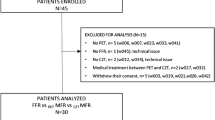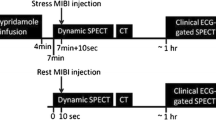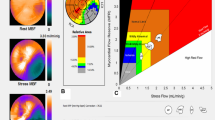Abstract
Purpose
Myocardial blood flow (MBF) quantification with dynamic SPECT could lead to widespread utilization of MBF imaging in clinical practice with little cost increase over current standard SPECT myocardial perfusion imaging. This work evaluates the feasibility and operator-dependent variability of MBF and flow reserve measurements with 99mTc-sestamibi (MIBI) dynamic SPECT imaging using a standard dual-head SPECT camera.
Methods
Twenty-eight patients underwent dipyridamole-stress and rest imaging with dynamic SPECT/CT acquisition. Quantitative images were iteratively reconstructed with all physical corrections and then myocardial and arterial blood regions of interest (ROI) were defined semi-automatically. A compartmental model was fitted to these ROI-sampled time-activity-curves, and flow-dependent MIBI extraction correction was applied to derive regional MBF values. Myocardial flow reserve (MFR) was estimated as stress/rest MBF ratio. MBF and MFR in low and high risk populations were evaluated for ability to detect disease. Images were each processed twice (≥7 days apart) by one expert and one novice operator to evaluate intra- and inter-operator variability of MBF and MFR measurement in the three coronary artery vascular territories.
Results
Mean rest flow, stress flow, and MFR values were 0.83, 1.82 mL·minute−1·g−1, and 2.45, respectively. For stress/rest MFR, the inter-operator reproducibility was r 2 = 0.86 with RPC = 1.1. Stress MBF and MFR were significantly reduced (P < .05) in high risk (n = 9) vs low risk populations (n = 19), indicating ability to detect disease. For expert and novice operators very good intra-operator correlations of r 2 = 0.98 and 0.95 (n = 168, P < .001) were observed for combined rest and stress regional flow values. Bland-Altman reproducibility coefficients (RPC) were 0.25 and 0.47 mL·minute−1·g−1 for the expert and novice operators, respectively (P < .001). Inter-operator correlation was r 2 = 0.91 and Bland-Altman RPC = 0.58 mL·minute−1·g−1 (n = 336).
Conclusions
MBF and reserve measurements using 99mTc-sestamibi on a traditional, two-headed camera with fast rotation and with quantitative dynamic SPECT appears to be feasible, warranting further investigation.







Similar content being viewed by others
References
Uren NG, Marraccini P, Gistri R, de Silva R, Camici PG. Altered coronary vasodilator reserve and metabolism in myocardium subtended by normal arteries in patients with coronary artery disease. J Am Coll Cardiol 1993;3:650-8.
Gould KL. Does coronary flow trump coronary anatomy? JACC Cardiovasc Imaging 2009;8:1009-23.
Yoshinaga K, Katoh C, Noriyasu K, Iwado Y, Furuyama H, Ito Y, et al. Reduction of coronary flow reserve in areas with and without ischemia on stress perfusion imaging in patients with coronary artery disease: A study using oxygen 15-labeled water PET. J Nucl Cardiol 2003;3:275-83.
Parkash R, deKemp RA, Ruddy TD, Kitsikis A, Hart R, Beauschene L, et al. Potential utility of rubidium 82 PET quantification in patients with 3-vessel coronary artery disease. J Nucl Cardiol 2004;4:440-9.
Ziadi MC, deKemp RA, Williams K, Guo A, Renaud JM, Chow BJ, et al. Does quantification of myocardial flow reserve using rubidium-82 positron emission tomography facilitate detection of multivessel coronary artery disease? J Nucl Cardiol 2012;4:670-80.
Zeintl J, Vija AH, Yahil A, Hornegger J, Kuwert T. Quantitative accuracy of clinical 99mTc SPECT/CT using ordered-subset expectation maximization with 3-dimensional resolution recovery, attenuation, and scatter correction. J Nucl Med 2010;6:921-8.
Bailey DL, Willowson KP. An evidence-based review of quantitative SPECT imaging and potential clinical applications. J Nucl Med 2013;1:83-9.
Gulberg GT, Reutter BW, Sitek A, Maltz JS, Budinger TF. Dynamic single photon emission tomography: Basic principles and cardiac applications. Phys Med Biol 2010;55:R111-91.
Klein R, Beanlands RS, deKemp RA. Quantification of myocardial blood flow and flow reserve: Technical aspects. J Nucl Cardiol 2010;17:555-70.
Herrero P, Markham J, Shelton ME, Bergmann SR. Implementation and evaluation of a two-compartment model for quantification of myocardial perfusion with rubidium-82 and positron emission tomography. Circ Res 1992;70:496-507.
Herrero P, Markham J, Shelton M, Weinheimer C, Bergmann S. Noninvasive quantification of regional myocardial perfusion with rubidium-82 and positron emission tomography. Exploration of a mathematical model. Circulation 1990;82:1377-86.
Hutchins GD, Schwaiger M, Rosenspire KC, Krivokapich J, Schelbert H, Kuhl DE. Noninvasive quantification of regional blood flow in the human heart using N-13 ammonia and dynamic positron emission tomographic imaging. J Am Coll Cardiol 1990;5:1032-42.
Iida H, Kanno I, Takahashi A, Miura S, Murakami MT, Takahashi K, et al. Measurement of absolute myocardial blood flow with H215O and dynamic positron-emission tomography. Strategy for quantification in relation to the partial-volume effect. Circulation 1988;78:104-15.
Iida H, Yokoyama I, Agostini D, Banno T, Kato T, Ito K, et al. Quantitative assessment of regional myocardial blood flow using oxygen-15-labelled water and positron emission tomography: A multicentre evaluation in Japan. Eur J Nucl Med 2000;21:192-201.
Katoh C, Yoshinaga K, Klein R, Kasai K, Tomiyama Y, Manabe O, et al. Quantification of regional myocardial blood flow estimation with three-dimensional dynamic rubidium-82 PET and modified spillover correction model. J Nucl Cardiol 2012;4:763-74.
Lortie M, Beanlands RSB, Yoshinaga K, Klein R, Da Silva JN, deKemp RA. Quantification of myocardial blood flow with 82Rb dynamic PET imaging. Eur J Nucl Med Mol Imaging 2007;11:1765-74.
Nekolla SG, Miethaner C, Nguyen N, Ziegler SI, Schwaiger M. Reproducibility of polar map generation and assessment of defect severity and extent in myocardial perfusion imaging using positron emission tomography. Eur J Nucl Med 1998;9:1313-21.
Tahari AK, Lee A, Rajaram M, Fukushima K, Lodge MA, Lee BC, et al. Absolute myocardial blood flow quantification with 82-Rb PET/CT: Comparison of different software packages and methods. Eur J Nucl Med Mol Imaging 2014;41:126-35.
deKemp R, Declerck J, Klein R, Pan XB, Nakazato R, Tonge C, et al. Multisoftware reproducibility study of stress and rest myocardial blood flow assessed with 3D dynamic PET/CT and a 1-tissue-compartment model of 82Rb kinetics. J Nucl Med 2013;54:571-7.
Ben-Haim S, Murthy VL, Breault C, Allie R, Sitek A, Nathaniel R, et al. Quantification of myocardial perfusion reserve using dynamic SPECT imaging in humans: A feasibility study. J Nucl Med 2013;54:873-9.
Brambilla M, Cannillo B, Dominietto M, Leva L, Secco C, Inglese E. Characterization of ordered-subsets expectation maximization with 3D post-reconstruction Gauss filtering and comparison with filtered backprojection in 99mTc SPECT. Ann Nucl Med 2005;19:75-82.
Seret A, Forthomme J. Comparison of different types of commercial filtered backprojection and ordered-subset expectation maximization SPECT reconstruction software. J Nucl Med Technol 2009;37:179-87.
Klein R, Renaud JM, Ziadi MC, Thorn SL, Adler A, Beanlands RS, et al. Intra- and inter-operator repeatability of myocardial blood flow and myocardial flow reserve measurements using rubidium-82 PET and highly automated analysis program. J Nucl Cardiol 2010;17:600-16.
Klocke FJ, Baird MG, Lorell BH, Bateman TM, Messer JV, Berman DS, et al. ACC/AHA/ASNC guidelines for the clinical use of cardiac radionuclide imaging. ACC/AHA practice guidelines. Circulation 2013;108:1404–18. http://circ.ahajournals.org/content/108/11/1404.full.
Dilsizian V, Bacharach SL, Beanlands RS, Bergmann SR, Delbeke D, Gropler RJ, et al. ASNC imaging guidelines for nuclear cardiology procedures. PET myocardial perfusion and metabolism clinical imaging. J Nucl Cardiol 2009. http://www.asnc.org/imageuploads/imagingguidelinespetjuly2009.pdf.
Efseaff M, Klein R, Beanlands RSB, deKemp RA. Short-term repeatability of resting myocardial blood flow measurements using rubidium-82 PET imaging. J Nucl Cardiol 2012;19:997-1006.
Leppo JA, Meerdink DJ. Comparison of the myocardial uptake of a technetium-labeled isonitrile analogue and thallium. Circ Res 1989;65:632-9.
Nagamachi S, Czernin J, Kim AS, et al. Reproducibility of measurements of regional resting and hyperemic myocardial blood flow assessed with PET. J Nucl Med 1996;10:1626-31.
Schindler TH, Zhang XL, Prior JO, Cadenas J, Dahlbom M, Sayre J, et al. Assessment of intra- and interobserver reproducibility of rest and cold pressor test-stimulated myocardial blood flow with 13N-ammonia and PET. Eur J Nucl Med Mol Imaging 2007;34:1178-88.
Nichols K, DePuey EG, Gooneratne N, Salensky H, Friedman M, Cochoff S. First-pass ventricular ejection fraction using a single-crystal nuclear camera. J Nucl Med 1994;35:1292-300.
Nichols K, DePuey EG, Rozanski A. First-pass radionuclide angiocardiography with single-crystal gamma cameras. J Nucl Cardiol 1997;4(1):61-73.
Johnson NP, Gould KL. Integrating noninvasive absolute flow, coronary flow reserve, and ischemic thresholds into a comprehensive map of physiological severity. J Am Coll Cardiol Imaging 2012;4:430-40.
Ziadi MC, Beanlands RSB. The clinical utility of assessing myocardial blood flow using positron emission tomography. J Nucl Cardiol 2010;4:571-81.
Ziadi MC, deKemp RA, Williams KA, Guo A, Chow BJ, Renaud JM, et al. Impaired myocardial flow reserve on rubidium-82 positron emission tomography imaging predicts adverse outcomes in patients assessed for myocardial ischemia. J Am Coll Cardiol 2011;58:740-8.
Prior JO, Allenbach G, Valenta I, Kosinski M, Burger C, Verdun FR, et al. Quantification of myocardial blood flow with 82Rb positron emission tomography: Clinical validation with 15O-water. Eur J Nucl Med Mol Imaging 2012;39:1037-47.
Nestrov SV, Han C, Mäki M, Kajander S, Naum AG, Helenius H, et al. Myocardial perfusion quantification with 15O-labeled water PET: High reproducibility of the new cardiac analysis software Carimas™). Eur J Nucl Med Mol Imaging 2009;10:1594-602.
Taylor R. Interpretation of the correlation coefficient: A basic review. J Diagn Med Sonogr 1990;6:35-9.
Bocher M, Blevis IM, Tsukerman L, Shrem Y, Kovalski G, Volokh L. A fast cardiac gamma camera with dynamic SPECT capabilities: Design, system validation and future potential. Eur J Nucl Med Mol Imaging 2010;37:1887-902.
Gerwitz H. PET measurement of adenosine stimulated absolute myocardial blood flow for physiological assessment of the coronary circulation. J Nucl Cardiol 2012;2:347-54.
Wyss CA, Koepfli P, Mikolajczyk K, Burger C, von Schulthess GK, Kaufmann PA. Bicycle exercise stress in PET for assessment of coronary flow reserve: Repeatability and comparison with adenosine stress. J Nucl Med 2003;2:146-54.
Crane P, Laliberte R, Heminway S, Thoolen M, Orlandi C. Effect of mitochondrial viability and metabolism on technetium-99m-sestamibi myocardial retention. Eur J Nucl Med 1993;20:20-5.
Hurwitz GA, Ghali SK, Husni M, Slomka PJ, Mattar AG, Reid RH, et al. Pulmonary uptake of technetium-99m-sestamibi induced by dipyridamole-based stress or exercise. J Nucl Med 1998;39:339-45.
El Fakhri G, Kardan A, Sitek A, Dorbala S, Abi-Hatem N, et al. Reproducibility and accuracy of quantitative myocardial blood flow assessment with 82Rb PET: Comparison with 13N-ammonia PET. J Nucl Med 2009;7:1062-71.
Renaud JM, Da Silva JN, Beanlands RSB, deKemp RA. Characterizing the normal range of myocardial blood flow with 82rubidium and 13N-ammonia PET imaging. J Nucl Cardiol 2013;20:578-91.
Kaufmann PA, Gnecchi-Ruscone T, Yap JT, Rimoldi O, Camici PG. Assessment of reproducibility of baseline and hyperemic myocardial blood flow measurements with 15O-labeled water and PET. J Nucl Med 1999;11:1848-56.
Orton EJ, Al-Harbi I, Klein R, Beanlands R, deKemp R, Wells RG. Prevalence of extra-cardiac interference in 82Rb PET myocardial perfusion imaging. J Nucl Med 2013;54:1689.
Acknowledgments
Research grant support was provided from Chang Bing Show Chwan Memorial Hospital (NO: CBSH-10010002).
Disclosure
Ran Klein receives license revenues from the sale of FlowQuant. Consultant for Jubilant-DraxImage and receives royalties from rubidium generator technology licenses. Robert deKemp receives license revenues from the sale of FlowQuant. Consultant for Jubilant-DraxImage and receives royalties from rubidium generator technology licenses. Guang-Uei Hung, Tao-Cheng Wu, Wen-Sheng Huang, Dianfu Li, Bailing Hsu have nothing to declare.
Author information
Authors and Affiliations
Corresponding author
Additional information
Ran Klein, Guang-Uei Hung, and Bailing Hsu have contributed equally to this study.
See related editorials, doi:10.1007/s12350-014-9996-z and doi:10.1007/s12350-014-0002-6.
Rights and permissions
About this article
Cite this article
Klein, R., Hung, GU., Wu, TC. et al. Feasibility and operator variability of myocardial blood flow and reserve measurements with 99mTc-sestamibi quantitative dynamic SPECT/CT imaging. J. Nucl. Cardiol. 21, 1075–1088 (2014). https://doi.org/10.1007/s12350-014-9971-8
Received:
Accepted:
Published:
Issue Date:
DOI: https://doi.org/10.1007/s12350-014-9971-8




